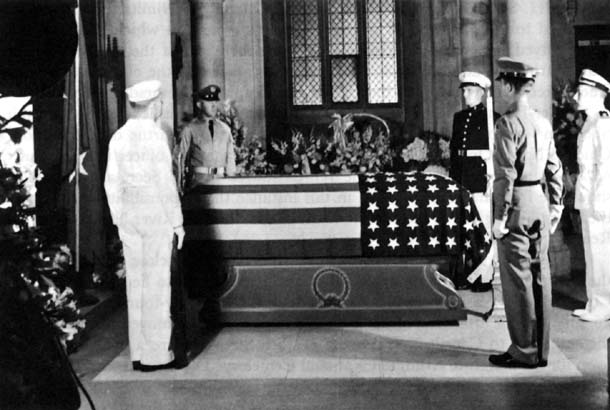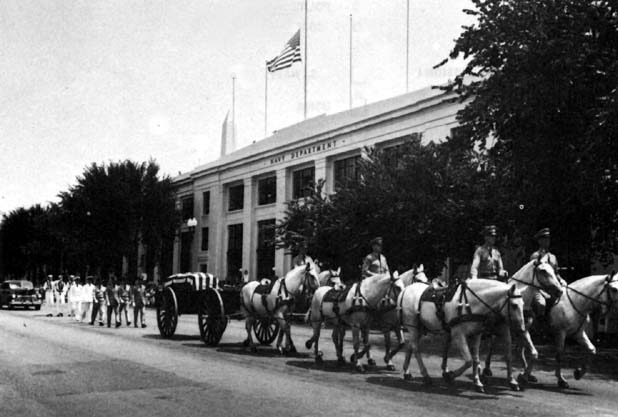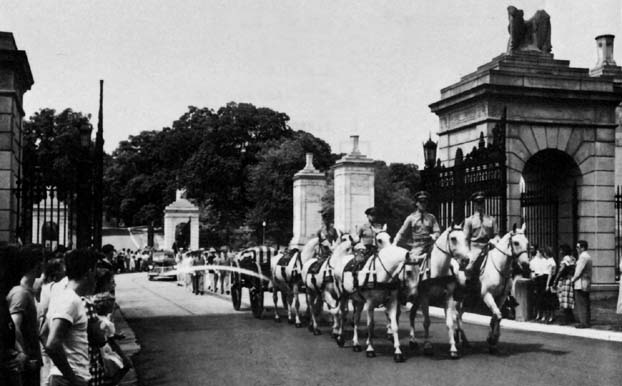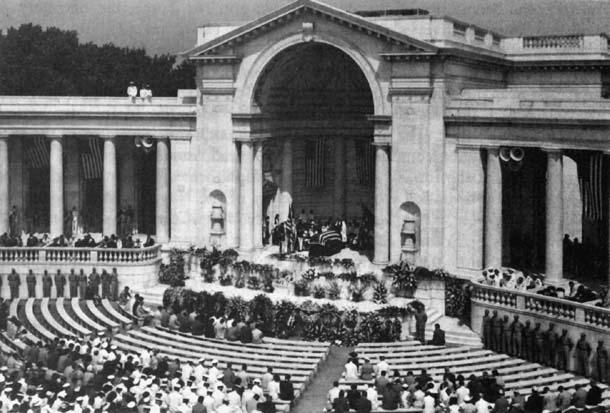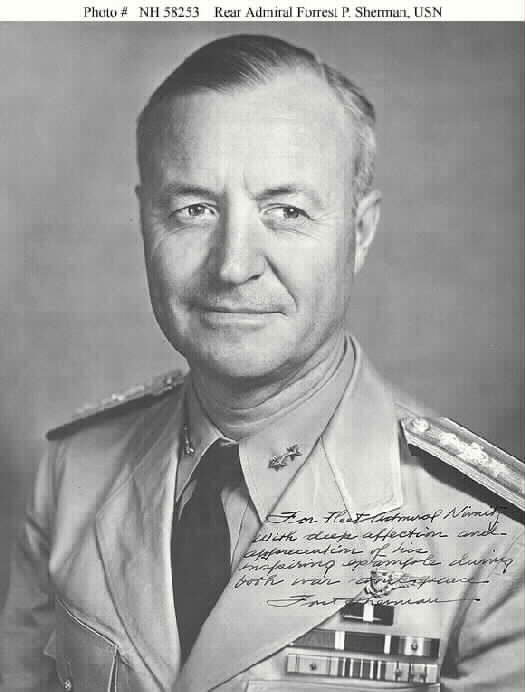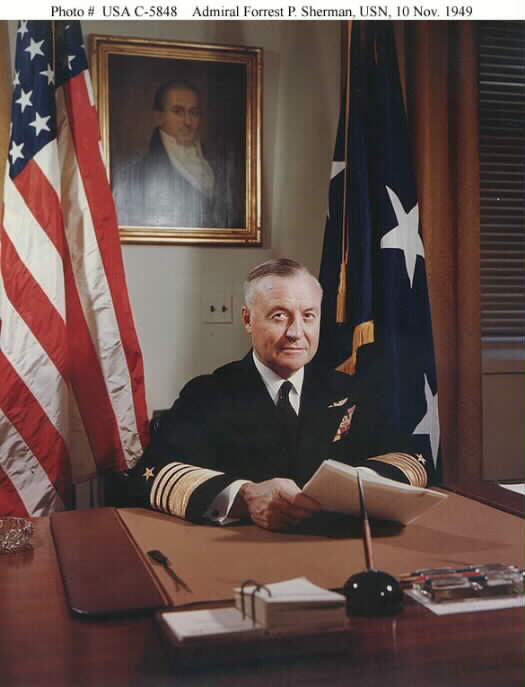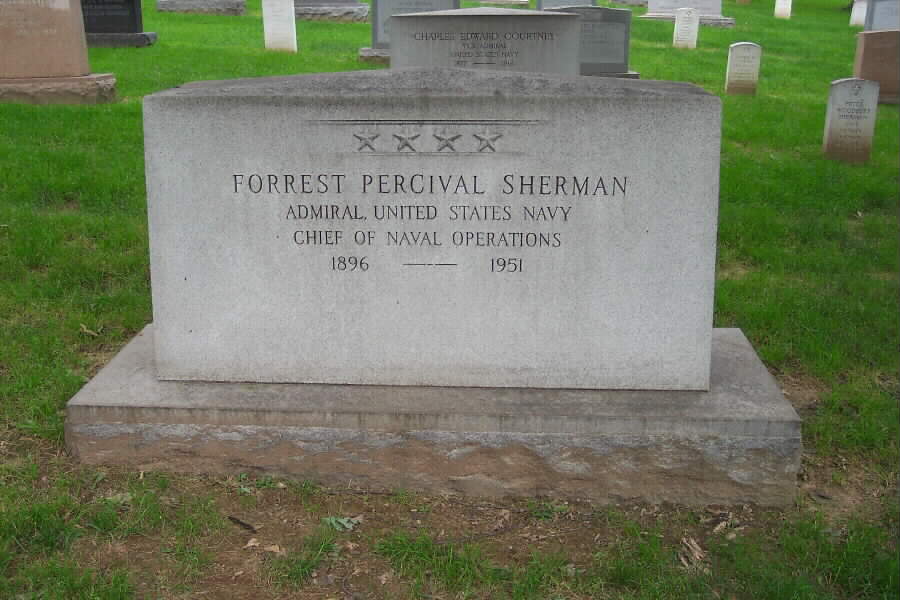NEWS RELEASES from the United States Department of Defense
No. 074-06 IMMEDIATE RELEASE
Navy to Commission New Guided Missile Destroyer Forrest Sherman
The newest Arleigh Burke class guided-missile destroyer, Forrest Sherman, will be commissioned at 11 a.m. ET on January 28, 2006, during a ceremony at Naval Air Station Pensacola, Florida.
Representative Jeff Miller of Florida’s 1st District will deliver the ceremony’s principal address. Ann Sherman Fitzpatrick will serve as sponsor of the ship named for her father. In a time-honored Navy tradition, she will give the first order to “man our ship and bring her to life!”
The new destroyer honors Admiral Forrest Percival Sherman who served as Chief of Naval Operations from November 1949 until his death on July 22, 1951. Following World War I service, he was designated a naval aviator and later served on the USS Lexington during the carrier’s first year in service. He twice held squadron commands aboard the USS Saratoga and served as navigator of the USS Ranger prior to joining the staff of commander, U.S. Fleet.
When World War II began, he served in the war plans division under the chief of naval operations. After assuming command of the USS Wasp in May 1942, he attained the rank of captain and earned the Navy Cross for his leadership of that ship during early phases of the occupation and defense of Guadalcanal in the Solomon Islands. After a Japanese submarine sank the USS Wasp on Sept. 15, 1942, he became chief of staff, to commander air force, Pacific Fleet and served in that capacity until November 1943, when he became Deputy Chief of Staff to Admiral Chester W. Nimitz. He earned a Distinguished Service Medal for his role in planning the captures of the islands of the Gilberts, Marshalls, Marianas, Western Carolines, Iwo Jima, and Okinawa.
Following a brief tenure as commander, U.S. Naval Forces, Mediterranean, Sherman became the youngest man ever to serve as chief of naval operations on November 2, 1949. One previous ship named in his honor, the USS Forrest Sherman (1955-1982), earned a Navy Unit Commendation and performed distinguished service off Lebanon (1958), Quemoy-Matsu (1958), Cuba (1961) and in the Indian Ocean (1980).
Commander Michael G. Van Durick of Pennsylvania will become the first commanding officer of the ship, which has accommodations for 383 officers and enlisted personnel. The 9,200-ton Forrest Sherman was built by Northrop-Grumman Ship Systems. It has an overall length of 509.5 feet, a waterline beam of 59 feet and a navigational draft of 32 feet. Four gas turbine engines will power the ship to speeds in excess of 30 knots.
The USS Forrest Sherman is the 48th of 62 Arleigh Burke-class destroyers currently authorized by Congress. This highly capable multi-mission ship can conduct a variety of operations, from peacetime presence and crisis management to sea control and power projection, in support of the National Military Strategy.
The ship will be capable of fighting air, surface, and subsurface battles simultaneously. The ship contains a myriad of offensive and defensive weapons designed to support maritime defense needs well into the 21st century.
Forrest Percival Sherman, Admiral, United States Navy, was born October 30, 1896, at Merrimack, New Hampshire. He attended the Massachusetts Institute of Technology for a year before entering the United States Naval Academy, from which he graduated in 1917.
He served on the USS Murray and the USS Nashville in European waters during 1917-19, receiving temporary promotion to Lieutenant and becoming permanent in that rank in 1920. He commanded the USS Barry, Atlantic Fleet in 1921.
He completed flight training at Pensacola, Florida, Naval Air Station in 1922, and in 1923-24 he was attached to Fighting Plane Squadron 2 aboard the carrier Aroostook. He was on the training staff at Pensacola in 1924-26, and after graduating from the Naval War College in 1927, he served tours on the carriers Lexington and Saratoga. In 1930-31 he was an instructor at the Naval Academy, returning to the Saratoga in 1931, assuming command of Fighting Squadron 1 in 1932. He commanded Fighting Wing in 1932-33.
After three years as Chief of Aviation Ordnance in the Bureau of Ordnance, he was assigned to the USS Ranger in 1936, and in 1937, promoted to Commander, was made Fleet Aviation Officer on the staff of the Commander of the U.S. Fleet.
Early in 1940 he was assigned to the Office of the Chief of Naval Operations. In May 1942, then a Captain, he took command of the carrier Wasp in Admiral Frank Jack Fletcher’s carrier force. On September 15 the Wasp was sunk by Japanese torpedoes during the Guadalcanal campaign. He then became Aide and Chief of Staff to the Commander of the Pacific Fleet, Admiral John H. Towers.
He was promoted to Rear Admiral in April . In November became Deputy Chief of Staff under Admiral Chester W. Nimitz. He took command of Carrier Division 1 in October 1945 and two months later was named Deputy Chief of Naval Operations with the rank of Vice Admiral. In that post he played a major role in the negotiations preceding the unification of the armed forces and in the establishment of the postwar network of Naval bases around the world. He and General Lauris Norstad were principal authors of the National Security Act of 1947.
In January 1948 he was put in command of Naval forces in the Mediterranean, which were reorganized in June as the 6th Fleet, and in November 1949 he became the Chief of Naval Operations with the rank of Admiral. He was still in that post when he died of heart attack, July 22, 1951, at Naples, Italy, during round of discussions on European defense. He was laid to rest in Arlington National Cemetery, Section 30. Grave 633.
His brother, Paul D. Sherman, Brigadier General, United States Marine Corps, is buried next to him.
Chief of Naval Operations
Admiral Forrest P. Sherman
Special Military Funeral
22-27 July 1951
Admiral Forrest P. Sherman, the youngest officer to hold the post of Chief of Naval Operations, died unexpectedly on 22 July 1951 in Naples, Italy, at the age of fifty-four. He had been touring the North Atlantic Treaty Organization defense area and was visiting Admiral Robert B. Carney, commander of the North Atlantic Treaty Organization forces in southern Europe, as his last stop before he returned to the United States. Admiral Sherman suffered a heart attack early in the morning and a second and fatal attack just after noon.
Word of his death was dispatched to Washington and his body was moved from the hotel to the Mount Olympus, Admiral Carney’s flagship, in Naples Harbor. A brief funeral service was held aboard the Mount Olympus on the morning of 24 July, while four United States destroyers formed a floating guard of honor around the flagship.
After the ceremony the admiral’s casket, draped with an American flag, was taken ashore, placed in an Italian hearse, and escorted by Italian motor police to Naples’ Capodichino Airport, where it was put aboard a Navy transport plane for return to the United States. An Italian armed forces guard and band rendered honors a few minutes before the plane departed.
When the Navy transport arrived at Washington National Airport on the afternoon of 25 July, the following prominent civil and military officials were there to honor Admiral Sherman: Secretary of Defense George C. Marshall; Secretary of State Dean G. Acheson; Secretary of the Army Frank Pace, Jr.; Secretary of the Navy Francis P. Matthews; Secretary of the Air Force Thomas K. Finletter; Deputy Secretary of Defense Robert A. Lovett; Under Secretary of the Navy Dan A. Kimball; Assistant Secretary of the Navy John T. Koehler; Assistant Secretary of the Navy for Air John F. Floberg; Chairman, Joint Chiefs of Staff, General of the Army Omar N. Bradley; Army Chief of Staff General J. Lawton Collins; Acting Chief of Naval Operations Admiral Lynde D. McCormick; Air Force Chief of Staff General Hoyt S. Vandenberg; Commandant of the Marine Corps General Clifton B. Cates; Assistant Commandant of the Marine Corps Lieutenant General Merwin H. Silverthorn; and Fleet Admiral Chester W. Nimitz. No planes were permitted to land or take off’ during a brief ceremony in which the U.S. Navy Band played ruffles and flourishes while three members of the clergy and a seaman bearing the admiral’s colors escorted the casket past the officials to a hearse. The casket was then taken to the US Naval Hospital in Bethesda, Maryland.
Under Department of Defense policies and plans published in 1949, Admiral Sherman was to be given a Special Military Funeral by virtue of his position as Chief of Naval Operations. Policy also prescribed that the officer in charge of funeral arrangements, acting as the representative of the Secretary of Defense, should be from the same service; in this instance the responsibility for arranging the funeral was given to the commandant of the Potomac River Naval Command, Rear Admiral George H. Fort.
According to the plan drawn up by Admiral Fort in close consultation with the Sherman family, the body of Admiral Sherman was to lie in the Bethlehem Chapel of the Washington National Cathedral for twenty-four hours, beginning 26 July. On the afternoon of the 27th, the body was to be moved in a hearse from the cathedral to Constitution Avenue at 15th Street, where a procession was to form for the march to Arlington National Cemetery. The funeral service was to be held in the Memorial Amphitheater, and burial was to be in Section 30 of the cemetery, the same northeastern section which contained the graves of William Howard Taft and James V. Forrestal. Graveside rites were to be attended only by members of the family.
On 26 July Admiral Sherman’s body was moved from the Naval Hospital to the Washington National Cathedral, where it remained in the Bethlehem Chapel from the afternoon of the 26th to the afternoon of the 27th. An honor guard of members from all services maintained a constant vigil at the casket, but the chapel was not open to the public.
Early in the afternoon of 27 July, Admiral Sherman’s casket was taken by hearse from the cathedral to Constitution Avenue at 15th Street, where it was transferred to a caisson for movement in procession to the cemetery. The military escort of the procession included units of the active Army, Navy, Marine Corps, and Air Force. As prescribed for Special Military Funerals, a military escort was to comprise two bands, a battalion of cadets from the appropriate academy, a company or comparable unit from each of the combat arms of the Army, and a company from each of the other armed forces. But this prescription was not rigid and in the arrangements for Admiral Sherman’s funeral it was modified by adding to the escort a third band, a second battalion of cadets, and a composite company of servicewomen – a platoon each from the Women Accepted for Volunteer Emergency Service, Women’s Army Corps, Women in the Air Force, and Women Marines. Admiral Fort, the escort commander, thus led approximately 1,500 troops, constituting three marching groups, each of about the same strength and each including a band. Scheduled to fly over the procession were 137 Navy and Marine Corps planes, including 44 jets, 48 Corsairs, 36 Skyraiders, and 9 Mercator patrol bombers. A special honor guard was to march in the cortege directly behind the caisson. The twelve members were Fleet Admiral William D. Leahy; General of the Army Omar N. Bradley, Chairman, Joint Chiefs of Staff; General J. Lawton Collins, Chief of Staff, US Army; Admiral Lynde D. McCormick, Acting Chief of Naval Operations; General Hoyt S. Vandenberg, Chief of Staff, US Air Force; General Clifton B. Cates, Commandant, US Marine Corps; Vice Admiral Merlin O’Neill, Commandant, US Coast Guard; General Wade H. Haislip, Vice Chief of Staff, US Army; Vice Admiral Donald B. Duncan, Deputy Chief of Naval Operations; General Nathan F. Twining, Vice Chief of Staff, US Air Force; Lieutenant General. Merwin H. Silverthorn, Assistant Commandant, US Marine Corps; and Rear Admiral Alfred C. Richmond, Assistant Commandant, US Coast Guard. Next in the procession were the following thirty-six honorary pallbearers, chiefly from the Navy, all of them either flag or general officers:
Admiral Arthur W. Radford
Vice Admiral Oscar C. Badger
Admiral William M. Fechteler
Vice Admiral John L. McCrea
Admiral Robert B. Carney
Vice Admiral Arthur D. Struble
Admiral Russell S. Berkey (retired)
Vice Admiral Thomas L. Sprague
Admiral Raymond A. Spruance (retired)
Vice Admiral Laurance T. DuBose
Admiral John H. Towers (retired)
Vice Admiral Francis S. Low
Admiral Thomas C. Kinkaid (retired)
Vice Admiral John H. Cassady
Admiral Dewitt C. Ramsey (retired)
Vice Admiral Jerauld Wright
Admiral Louis E. Denfeld (retired)
Rear Admiral Charles C. Hartman
Admiral William H. P. Blandy (retired)
Rear Admiral Henry S. Kendall
Admiral Claude C. Bloch (retired)
Rear Admiral William K. Harrill (retired)
Vice Admiral Arthur C. Davis
Rear Admiral Richard E. Byrd (retired)
Vice Admiral John J. Ballentine
Lieutenant General Franklin A. Hart, US Marine Corps
Vice Admiral Felix B. Stump
Vice Admiral Charles P. Mason (retired)
Lieutenant General Graves B. Erskine, US Marine Corps
Vice Admiral Arthur C. Miles (retired)
Vice Admiral Edward L. Cochrane (retired)
Major General Field Harris, US Marine Corps
Vice Admiral Harry W. Hill
Brigadier General Clayton C. Jerome, US Marine Corps
Vice Admiral Richard L. Conolly
Vice Admiral John D. Price
Immediately behind the honorary pallbearers was the Sherman family group and bringing up the rear of the cortege were a number of civil dignitaries. These included the Secretary of Defense, Deputy Secretary of Defense, Secretary of the
Treasury, the Secretaries of the Army, Navy, and Air Force, the Secretary of State, and representatives of the diplomatic corps.
The procession moved to the cemetery via Constitution Avenue, 23d Street, Memorial Bridge, and Memorial Drive. Squadrons of planes in diamond formation passed over the column when it approached the Memorial Gate of the cemetery. As Admiral Fort led the column through the gate, the 3d Infantry battery opened a 17-gun salute. The firing was timed to match the movement of the procession at slow cadence from the gate to the Memorial Amphitheater.
Attendance at the funeral service in the amphitheater, which was scheduled for 1500, was by invitation from the Secretary of the Navy; invitations and responses to them were administered by the Office of the Chief of Naval Personnel. President Harry S. Truman attended and, as was his custom, dispensed with the honors and gun salute that usually signaled the arrival and departure of the President. Among other distinguished civilians invited were members of the cabinet, Supreme Court, Congress, Department of Defense, and diplomatic corps. Representatives of patriotic groups whose organizations had received government approval also were asked. From the armed forces, active and retired flag officers of the Navy and Coast Guard and active and retired general officers of the Marine Corps were invited. Only active general officers of the Army and Air Force received invitations.
The funeral service was conducted by the Very Reverend F. Merritt Williams, dean of St. Paul’s Episcopal Cathedral in Springfield, Massachusetts, and the Reverend C. Leslie Glenn, rector of St. John’s Episcopal Church in Washington, D.C., both commanders in the Navy Reserve. The Reverend Dr. Williams had been aboard the carrier Wasp, commanded then by Captain Sherman, when the ship was sunk east of Guadalcanal on 15 September 1942. The service, which lasted about fifteen minutes, included hymns, prayers, and scriptural readings. At its conclusion, the US Marine Band played what is known as the Navy hymn, “Eternal Father, Strong to Save.”
The graveside service, restricted to members of the Sherman family, also was brief. The 3d Infantry battery fired a second 17-gun salute as the rites began. Following a reading of the service, prayers, and the benediction, the traditional three volleys and the sounding of taps closed the ceremonies.
Admiral Sherman lying in State at the Washington Cathedral
Admiral Sherman’s procession moves along Constitution Avenue
Admiral Sherman’s procession enters Arlington National Cemetery
Admiral Sherman’s funeral serice at the Memorial Amphitehater
United States Navy Photos
NEWS RELEASE from the United States Department of Defense
No. 033-03
NAVY NAMES NEW DESTROYERS HONORING NAVAL HEROES
Secretary of the Navy Gordon R. England has selected the names of three great naval heroes for the next Arleigh Burke class guided-missile destroyers. Fleet Adm. William F. Halsey, Jr., Adm. Forrest Sherman and Adm. David Glasgow Farragut will each have a guided-missile destroyer sail under their names.
The Halsey honors Admiral William F. Halsey, Jr. (1882-1959). During World War I, Cmdr. Halsey was awarded the Navy Cross for his actions while in command of USS Benham and USS Shaw during convoy escort duties.
Designated a naval aviator in 1935 at the age of 52, he took command of USS Saratoga from 1935 until 1937. In February 1942, then Vice Adm. Halsey while serving as commander, Carrier Division Two aboard the flagship USS Enterprise, led the first counter-strikes of World War II against the Japanese with carrier raids on the Gilbert and Marshall Islands. Later that year, his task force launched the famous “Doolittle Raid” against targets on the Japanese homeland.
Assigned as commander, South Pacific Force and South Pacific Area on October 18, 1942, Halsey led the Navy, Marine Corps, and Army forces that conquered the strategically important Solomon Islands. Subsequently as commander, Third Fleet, his task forces consistently won hard fought victories during campaigns in the Philippines, Okinawa, and other islands. Nicknamed “Bull” Halsey he embodied his slogan, “Hit hard, hit fast, hit often.” On December 11, 1945, he became the fourth officer to hold the rank of fleet admiral. One previous ship has been named Halsey (1963-1994), which earned eight battle stars for Vietnam Service in addition to a Navy Unit Commendation and a Meritorious Unit commendation, and participated in contingency operations in Korean waters (1969-1971) and in the Indian Ocean (1980). Northrop-Grumman Ship Systems in Pascagoula, Miss., will build Halsey.
The Forrest Sherman honors Adm. Forrest Percival Sherman (1896-1951). Sherman served as Chief of Naval Operations from November 1949 until his death on July 22, 1951. Following World War I service, he was designated a naval aviator and later served in USS Lexington during the carrier’s first year in commission. He twice held squadron commands on the USS Saratoga and served as navigator on the USS Ranger prior to joining the staff of commander, U.S. Fleet in February 1940. When World War II began, he served in the War Plans Division under the Chief of Naval Operations. After assuming command of the USS Wasp in May 1942, he attained the rank of Captain and earned the Navy Cross for his leadership of that ship during early phases of the occupation and defense of Guadalcanal in the Solomon Islands. After a Japanese submarine sank the Wasp on Sept. 15, 1942, he became chief of staff, to commander Air Force, Pacific Fleet and served in that capacity until November 1943, when he became deputy chief of staff to Adm. Chester W. Nimitz. He earned a Distinguished Service Medal for his role in planning the capture of the Gilberts, Marshalls, Marianas, Western Carolines, Iwo Jima, and Okinawa. Following a brief tenure as commander, U.S. Naval Forces, Mediterranean, Sherman became the youngest man ever to serve as Chief of Naval Operations on Nov. 2, 1949. One previous ship, USS Forrest Sherman (1955-1982) was named in his honor, earned a Navy Unit Commendation and performed distinguished service off Lebanon (1958), Quemoy-Matsu (1958), Cuba (1961), and in the Indian Ocean (1980). Northrop-Grumman Ship Systems in Pascagoula, Miss., will build the Sherman.
The Farragut honors Admiral David Glasgow Farragut (1801-1870). One of the Union’s great heroes, Farragut gained famed for his exploits while in command of the West Gulf Blockading Squadron during the Civil War. In 1862 his ships fought past Confederate forts to capture New Orleans, proving for the first time that cities could be taken by naval forces. In 1863 at Vicksburg, he gained control of the Mississippi splitting the Confederacy. In 1864 he boldly led his squadron through a minefield to win the Battle of Mobile Bay. Four previous ships have been named Farragut: A Torpedo Boat (1899-1919); a destroyer (1920-1930); a destroyer (1934-1945) that earned fourteen battle stars in World War II (including Pearl Harbor, Coral Sea, Eastern Solomons, Iwo Jima, and Okinawa); and a guided-missile destroyer (1960-1989) that took part in contingency operations in the Atlantic and Mediterranean and earned a Navy Unit Commendation. Bath Iron Works, a General Dynamics Co., in Maine will build Farragut.
The Halsey, Sherman and Farragut are Flight IIA variants of the Arleigh Burke class guided-missile destroyer, and incorporate a helicopter hanger facility into the original design. The ships can carry two SH-60B/R helicopters. Guided-missile destroyers operate independently and in conjunction with carrier battle groups, surface action groups, amphibious groups and replenishment groups.
Michael Robert Patterson was born in Arlington and is the son of a former officer of the US Army. So it was no wonder that sooner or later his interests drew him to American history and especially to American military history. Many of his articles can be found on renowned portals like the New York Times, Washingtonpost or Wikipedia.
Reviewed by: Michael Howard

